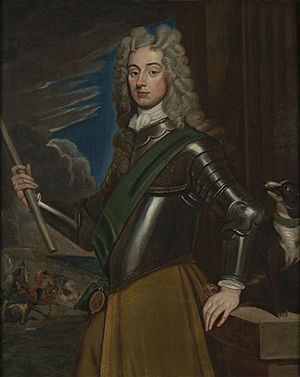John Dalrymple, 2nd Earl of Stair facts for kids
Quick facts for kids
The Earl of Stair
|
|
|---|---|

Portrait, c. 1700
|
|
| Born | 20 July 1673 Edinburgh, Scotland |
| Died | 9 May 1747 (aged 73) Edinburgh, Scotland |
| Allegiance | |
| Service/ |
|
| Rank | Field marshal |
| Battles/wars | |
| Awards | Knight of the Thistle |
Field Marshal John Dalrymple, 2nd Earl of Stair (born 20 July 1673, died 9 May 1747) was an important Scottish soldier and diplomat. He served in major wars like the Nine Years' War and the War of the Spanish Succession. Later, he was a British Ambassador in Paris. He also led troops in the Battle of Dettingen during the War of the Austrian Succession.
Contents
Becoming a Soldier: Early Career
John Dalrymple was born in Edinburgh, Scotland. His father was John Dalrymple, who later became the 1st Earl of Stair. John spent much of his early life studying in the Netherlands.
He joined the army as a volunteer during the Nine Years' War. He fought bravely at the Battle of Steenkerque in August 1692. During this battle, he kept his regiment together even when they were under heavy cannon fire. In 1695, he became "Master of Stair" when his father received the title of Earl of Stair.
Fighting with the Duke of Marlborough
In May 1702, John became a lieutenant colonel in the 3rd Foot Guards. He fought alongside the famous Duke of Marlborough in the War of the Spanish Succession. He took part in battles like Peer and Venlo in 1702. At Venlo, he even saved the life of the Prince of Hesse-Kassel!
In 1703, he became Viscount Dalrymple. In 1706, he was made a colonel. He led a group of soldiers at the Battle of Ramillies in May 1706. He was promoted to brigadier general and then became colonel of the Grey Dragoons.
When his father died in January 1707, John became the 2nd Earl of Stair. That same year, he was chosen as one of the Scottish representatives in the new Parliament of Great Britain.
Leading Troops in Big Battles
He continued to lead soldiers in important battles. He commanded a brigade at the Battle of Oudenarde in July 1708. He also fought during the Siege of Lille later that year.
In 1709, he was promoted to major general. He then fought at the Battle of Malplaquet in September 1709. This was one of the bloodiest battles of the war.
After this, the Duke of Marlborough sent him on a special mission to Poland. He returned in time to join the Siege of Douai in April 1710. He was promoted again to lieutenant general in June 1710. He fought at the Siege of Bouchain in August 1711. That year, he also received a special award, becoming a Knight of the Thistle.
In 1712, he went to Flanders for another military campaign. In 1714, he became colonel of the Black Dragoons.
Diplomatic Service: Ambassador to France
When King George I became king in 1714, John Dalrymple was sent to France as an ambassador. He worked at the French court in Versailles.
He quickly made friends with the Duke of Orléans, who was ruling France for the young King Louis XV. This helped create a special agreement called the Triple Alliance. While in Paris, Dalrymple's spies helped stop plots by the Jacobites, who wanted to bring back the old royal family.
From 1715 to 1720, he was based in Versailles. He was very impressed by the beautiful gardens there.
Retirement and Garden Design
Dalrymple left his job as ambassador in France in June 1720. When he returned to Scotland, he used his inspiration from Versailles. He designed and planted amazing gardens at his own homes, Newliston House and Castle Kennedy.
In 1729, he became Vice Admiral of Scotland. However, he lost this job in 1733. This was because he disagreed with Prime Minister Robert Walpole's new tax plan, called the Excise Bill.
He was promoted to full general in 1735. He also spent time in the 1730s designing the gardens at Castle Kennedy.
War of the Austrian Succession: Leading the Army
In 1742, after Robert Walpole was no longer Prime Minister, Dalrymple was promoted to field marshal. He was also made Governor of Minorca.
In April 1742, he took command of the "Pragmatic Army." This army was sent to help the Austrian forces. Their goal was to support Maria Theresa in becoming Empress of Austria.
In 1743, he became Commander-in-Chief of the Forces in South Britain. He also became colonel of the Black Dragoons again. He led the allied forces to victory at the Battle of Dettingen in June 1743.
Because he was getting older, he asked to retire from leading the army in Flanders in September 1743. He also retired as Commander-in-Chief of the Forces in 1745.
In 1745, he became colonel of the Grey Dragoons. In 1746, he became General of the Marine Forces. His favorite home was Newliston near Kirkliston. Here, he continued to create beautiful gardens in the French style.
John Dalrymple died on 9 May 1747 in Edinburgh. He was buried in his family's tomb at Kirkliston.
Family Life
In March 1708, John Dalrymple married Lady Eleanor Primrose Campbell. She already had four children from a previous marriage. John and Eleanor did not have any children together.



